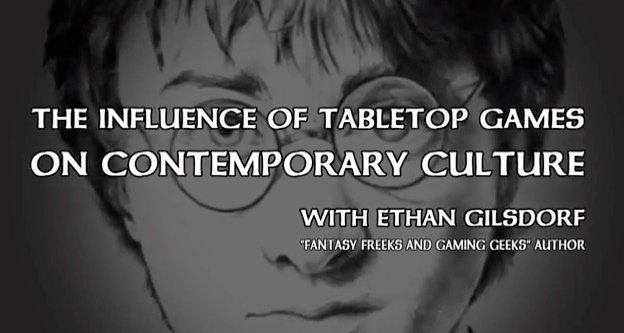All I needed to know about life I learned from “Dungeons & Dragons”
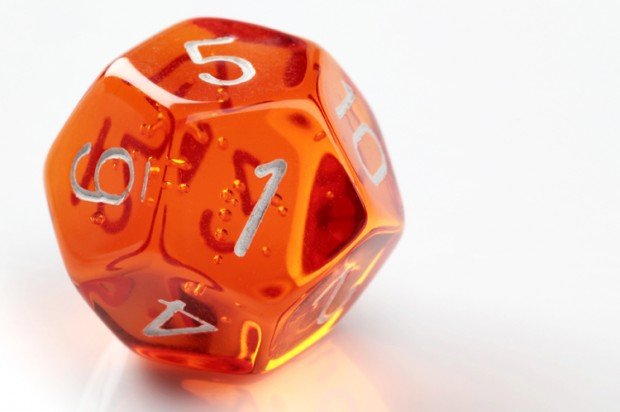 I was lucky enough to publish this piece on Salon.com, using the occasion of D&D's 40th anniversary this month to wax poetical about all the life lessons the game taught me.
I was lucky enough to publish this piece on Salon.com, using the occasion of D&D's 40th anniversary this month to wax poetical about all the life lessons the game taught me. I was lucky enough to publish this piece on Salon.com, using the occasion of D&D's 40th anniversary this month to wax poetical about all the life lessons the game taught me.
I was lucky enough to publish this piece on Salon.com, using the occasion of D&D's 40th anniversary this month to wax poetical about all the life lessons the game taught me.
Here's an excerpt:
I played a lot of D&D back in the 1970s and 1980s. After conquering me, D&D went on to transform geek culture. Not only had D&D invented a new genre of entertainment — the role-playing game — but it practically gave birth to interactive fiction and set the foundation for the modern video game industry. Into “Halo” or “Call of Duty”? You’re playing an incredibly sophisticated version of a D&D dungeon crawl.
After a long hiatus, I play the game again now, as a 47-year-old, mostly grown-up person. Today, with my +5 Goggles of Hindsight, I can see how D&D was subtly helping me come of age. Yes, it’s a fantasy game, and the whole enterprise is remarkably analog, powered by face-to-face banter, storytelling and copious Twizzlers and Doritos. But like any pursuit taken with seriousness (and the right dose of humor), Dungeons & Dragons is more than a mere game. Lessons can be applied to the human experience. In fact, all I really need to know about life I learned by playing D&D.
On WPR discussing D&D
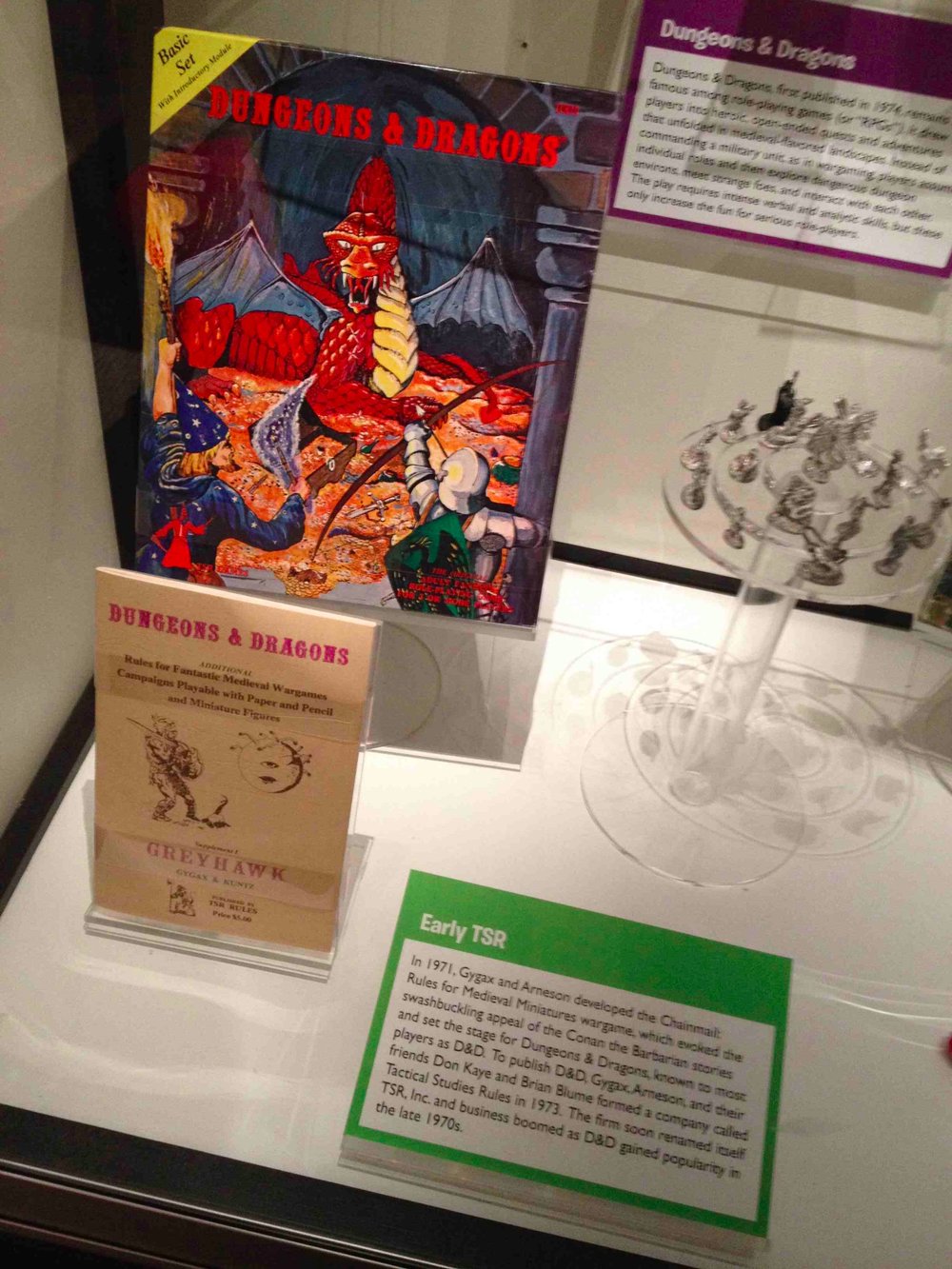 I appeared on Wisconsin Public Radio's "Central Time" Monday 1/20/14 at 4:45PM CST (5:45 ET) on a program about the 40th anniversary of D&D.
I appeared on Wisconsin Public Radio's "Central Time" Monday 1/20/14 at 4:45PM CST (5:45 ET) on a program about the 40th anniversary of D&D. The D&D display at the Strong Museum, Rochester, NY (Image: Ethan Gilsdorf)
The D&D display at the Strong Museum, Rochester, NY (Image: Ethan Gilsdorf)
I appeared on Wisconsin Public Radio's "Central Time" Monday 1/20/14 at 4:45PM CST (5:45 ET) on a program about the 40th anniversary of D&D (and Wisconsin native Gary Gygax) in a segment called "The Influence And Wisconsin Origins Of Dungeons and Dragons." The other guest was Dork Tower creator John Kovalic.
Hire me!
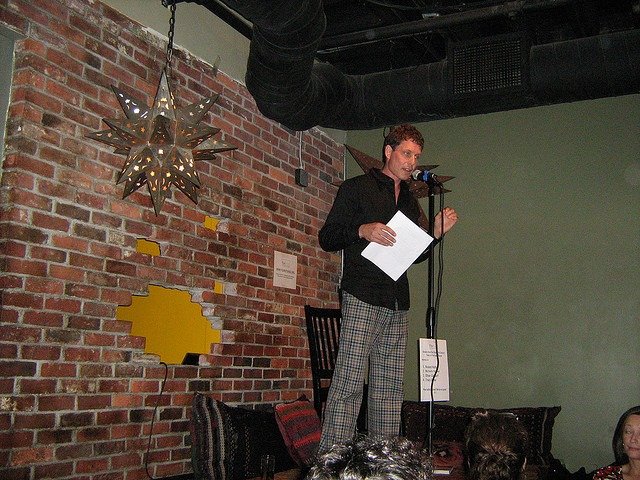 Ethan reads, makes world safe for geeks. Sometimes he wears these grampy pants.
Ethan reads, makes world safe for geeks. Sometimes he wears these grampy pants.
I've appeared at conventions like Pax East, Gen Con and DragonCon; read at book festivals in Atlanta, Brooklyn and Boston; spoken at universities like MIT, Notre Dame, Bryn Mawr and LSU; and appeared at dozens of bookstores, book groups, high schools, libraries, and other venues.
I've fought (badly) with foam swords in public. I'm not afraid to wear my chainmail and tunic. I've taught 25 newbies how to play Dungeons & Dragons in one evening.
If your bookstore, library, book group, writer's festival, college/university, high school, club, game shop, convention, bar, cafe, mother, etc. would like to book me to give a talk, slide-lecture, organize a discussion, teaching a writing class, or have moderate a panel or Q&A, let me know.
 Ethan reads, makes world safe for geeks. Sometimes he wears these grampy pants.
Ethan reads, makes world safe for geeks. Sometimes he wears these grampy pants.
I love to give talks and readings, slide presentations, moderate panels, teach creative writing and role-playing games, and inspire people to geek out.
I've appeared at conventions like Pax East, Gen Con and DragonCon; read at book festivals in Atlanta, Brooklyn and Boston; spoken at universities like MIT, Notre Dame, Bryn Mawr and LSU; and appeared at dozens of bookstores, book groups, high schools, libraries, and other venues.
I've fought (badly) with foam swords in public. I'm not afraid to wear my chainmail and tunic. I've taught 25 newbies how to play Dungeons & Dragons in one evening.
If your bookstore, library, book group, writer's festival, college/university, high school, club, game shop, convention, bar, cafe, mother, etc. would like to book me to give a talk, slide-lecture, organize a discussion, teaching a writing class, or have moderate a panel or Q&A, I am a hired gun looking for a microphone to speak into and some dice to roll. More info here.
For booking, rates and program details, contact me here.
For a schedule classes I'm already teaching, see this.
Here are some of the events I can happily bring to your lecture hall or dungeon. Custom topics and talks also possible.
Fantasy Freaks and Gaming Geeks: The Lecture:
An overview of my award-winning book, with a reading, and (if you want) slide-lecture that encapsulates my journey into fantasy and gaming subcultures (D&D, Lord of the Rings, Harry Potter, World of Warcraft, medieval re-enactors), what explains the appeal of these fantasy worlds, and my own journey to accept my inner geek.
How Dungeons & Dragons Saved My Life:
An inspiring talk about my personal history playing D&D and other role-playing games, and how they influenced me, changed my life, and helped me become a creative, socialized, and (mostly) full-adjusted human being I am today. With images from my personal gaming collection and the history of role-playing games.
I've Always Wanted to Play D&D, But ....: A Three-Hour Fantasy Role-Playing Game Experience:
Using a quick-start method and simplified version of the rules, I've developed a 3 to 5 hour D&D-like experience that even non-nerds can understand. In one session, you and your pals can play characters, go on an adventure, solve problems and defeat evil in your unique way, help tell a memorable story -- and have a great time. Dortitos and Mountaimn Dew can be arranged.
Writing Workshops:
Teen Writing Adventure (three-hour or day-long writing classes for kids); Adult Writing Bootcamps (same thing for adults: fiction, nonfiction, poetry); How to Be a Freelance Writer (Tips, strategies and craft basics for writing articles, essays and op-ed for publication)
Personal Coaching and Manuscript Editing:
I have more than 15 years experience as a freelance writer and teacher of writing. I'm available for editing, consulting, and coaching (and butt kicking), and to help guide and provide feedback for anyone out there working in nonfiction, essay, op-ed, personal essay, memoir, poetry and fiction. I also consult on book promotion.
The Original D&D Gets a New Deluxe Edition
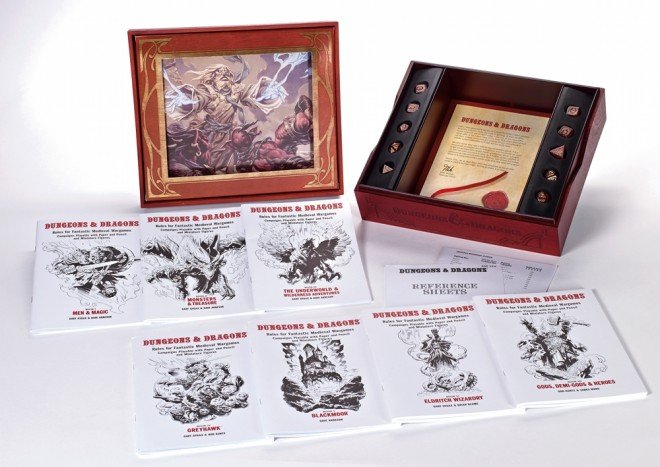

by Ethan Gilsdorf
Dungeons & Dragons (D&D) may be approaching its 40th birthday next year, and rapidly losing younger players to the irresistible eye-candy of digital gaming. But in one particular sector, the role-playing game business is still booming: Older gamers like me.
I grew up playing D&D, religiously, back in the Reagan Administration. My original "Monster Manual," "Dungeon Master Guide" and sack of polyhedral dice are still precious to me. Lucky for me, I hung onto my trove of rule books that were still covered with a layer of Cheetos dust. Other old-school games weren't so lucky. ("Thanks, Mom, for giving my stuff to Goodwill when I went off to college!") Now all grown up, and sometimes with children of their own, these gamers miss that place that face-to-face dice-rolling and storytelling experience played in their lives.
But fear not, old-school roleplaying games (RPGs) are back, one reissue at a time.
Wizards of the Coast (WotC), the company that owns the D&D brand, has embarked on a new campaign in the past year to recapture older gamers whose magic-users and paladins slayed many an orc and beholder and pillaged many a graph-paper-charted land. All year longWotC has been reprinting new editions of ancient tomes from the heyday of tabletop role-playing games. On November 19, the granddaddy of them all arrives: a deluxe edition of The White Box, the original D&D set (aka OD&D) first published by Tactical Studies Rules, or TSR, Inc, back in 1974. (In a Wired.com exclusive, a new photo of the final product prototype is pictured here.)
The White Box "was the very first roleplaying game, introducing concepts that have persisted throughout later editions," said Liz Schuh, director of publishing and licensing for D&D. "Many of our players have strong emotional connections to our classic products."
They better. This new White Box retails for $149.99.
All this nostalgia comes as D&D hits "middle age." In 2014, D&D, the first-ever commercially-available role-playing game, turns 40. Next year also brings (barring any delays) the release of the game's next iteration, D&D Next.
Is all this product retread a crass commercial move on the part of WotC, or a genuine desire to re-connect gamers in their forties, fifties and even sixties to their beloved dungeon-crawls pasts?
Whatever the interpretation, this is some powerful Spell of Nostalgia that WotC is casting. Go ahead, resist. Roll a saving throw versus
The campaign began last year, with new limited-editions of the 1st Edition rulebooks: the beloved AD&D "Monster Manual" (1977), "Player's Handbook" (1978), and "Dungeon Master’s Guide" (1979). Then, in January, WotC launched dndclassics.com, a site allowing oldbies to download in PDF format hundreds of forgotten and out-of-print gaming products, from the legendary 1978 module D3: Vault of the Drow to a 1981 edition of the D&D Basic Rulebook. Also released earlier this year: two volumes of compilations of classic adventures including one called "Dungeons of Dread" that features favorites like "Tomb of Horrors" and "Expedition to the Barrier Peaks." Second edition core rulebook "Premium" reprints came out in in May. Of course, official D&D merch --- from T-shirts, belts and iPhone cases --- is also being hawked. All of these products are replicated down to the last "to hit" chart and goofy drawing of kobolds, and gelatinous cubes (just testing you: gelatinous cubes are invisible).
That "White Box" facsimile set includes the original three OD&D booklets (Men & Magic; Monsters & Treasure; Underworld & Wilderness Adventures) plus the four supplements (Greyhawk; Blackmoor; Eldritch Wizardry; Gods, Demi-Gods & Heroes); a packet of "reference sheets"; and 10 funky-looking (but not historically accurate) dice. In a nod to the OD&D's original brown wood-grain cardboard box, it's all housed in a fancy engraved wooden case. The booklets' interior art looks the same, but the box's cover modern fantasy art (see photo) might annoy purists.
Original "white box" sets are rare, and can sell for $500 or more on eBay. With the reprints, anyone can own a piece of D&D history. Sort of.
Game designer James M. Ward, a veteran TSR employee who wrote the games Gamma World and Metamorphosis Alpha, and co-authored the core rulebook Deities & Demigods, took a more skeptical view towards WotC's decision to release items from the game's golden age. "Just think of the profit for releasing something they didn’t have to pay for or edit," Ward said. "It’s a move to make lots of money considering consumers are really liking the idea of old style material."
From the tabletop resurgence that’s been happening over the past few years, it’s clear that older gamers miss the dice-rolling and face-to-face interaction of an analog dungeon crawl. Even the the original TSR brand had been rebooted (not by Gygax's heirs or Wotc) and has released a publication, aptly named Gygax Magazine, in the spirit of the old Dragon and White Dwarf magazines. GenCon, Pax and Pax East prove there's an audience for non-digital entertainment. Older school-style RPGs such Pathfinder, from rival company Paizo Publishing, routinely outsells the last version of the D&D, the much-maligned 4th edition, released in 2008.
This "Old School Renaissance" is a welcome resurgence for people like Tim Kask, the first employee TSR ever hired and former editor of "Dragon" magazine. Kask and other older gamers maintain that newer iterations of D&D stripped out all the fun. "The game got so tabulated and charted that people forgot to ask questions," he said. "I think what has been ruled to death is that sense of wonderment, of not exactly knowing what is around the next corner."
So it makes sense that WotC also hopes some of the gamer will find their way back to a purer form of D*&D -- namely, the storytelling and mystery. "When you lose that, roleplaying," Kask said, D&D "becomes just killing at the zoo.”
If Wizards of the Coast wants to take old gamers like me on a journey down memory lane -- or back into memory's dungeon -- I can't complain. Maybe I'll never play that fancy White Box edition. In fact. I'm pretty wedded to my AD&D rule set from the 1980. But just to hold these new/old tomes, and flip through them, and roll the dice again ... Ahhh. Gary Gygax and Dave Arneson, D&D's co-creators, may be dead, but their legacy of Doritos-eating, dice-rolling and bantering around some basement table lives on. Hopefully, with these D&D reissues, enough younger players will also find their way to that experience.
So even if your original DM's Guide got tossed back in the Reagan Administration, you can game again, and play whatever version of D&D you like.
"From my way of thinking," James M. Ward said, "nothing was lost."
I'm on PBS's "Off Book" to discuss D&D
Exploring the origins of D&D for Wisconsin Public Radio
Dungeons and Dragons is the single most famous roleplaying game in the world. Writer Ethan Gilsdorf didn’t grow up in Wisconsin, but his love of D&D led him to fantasize about visiting the game’s hometown: Lake Geneva, hometown to Dungeons & Dragons co-creator Gary Gygax. In this cool radio piece, Ethan explores the origins of D&D for Wisconsin Public Radio.
Or you can listen to the mp3 here.
Mitt Romney as a D&D Character?
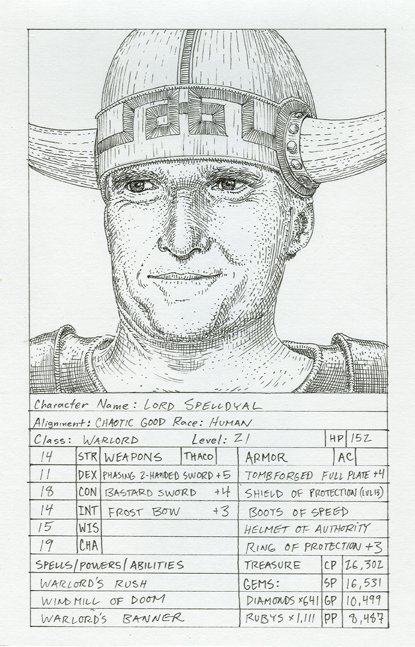 Now that Presidential candidate Mitt Romney is wailing on his opponents Newt, Rick, and Paul, perhaps it's time for his deeds to be enshrined as a D&D character.
Now that Presidential candidate Mitt Romney is wailing on his opponents Newt, Rick, and Paul, perhaps it's time for his deeds to be enshrined as a D&D character.
Artist Casey Jex Smith has been working on a series of works that depict people as D&D characters. Here, Mitt Romney, although unnamed, is shown as Lord Spelldyal, a 21st level warlord with 152 hit points, Boots of Speed and a Helmet of Authority.
The drawing was one of the works in the Dungeons and Dragons On & Ever Onward art show at the Soho Gallery of Digital Art in New York City. The show, which closed Jan 11, 2012, was curated by Timothy Hutchings, and featured works by Casey Jex Smith, Ryan Browning, Sean McCarthy, Rebecca Schiffman, Josh Jordan, Jeffrey Brown, Giovanni Garcia-Fenech, Chris Bors, Owen Rundquist, Andrew Guenther Jason Phillips, Ketta Ioannidou, Fiona MacNeill, Kitty Clark, Erol Otus, Steve Zeiser, Matt Brinkman, Chris Coy, and others.
And it featured historical selections from the Play-Generated Maps and Documents Archive.
More from Casey Jex Smith's D&D characters series here.
Image courtesy Allegra LaViola Gallery
[a version of this post originally appeared on wired.com's GeekDad]
Gygax Biopic in the works
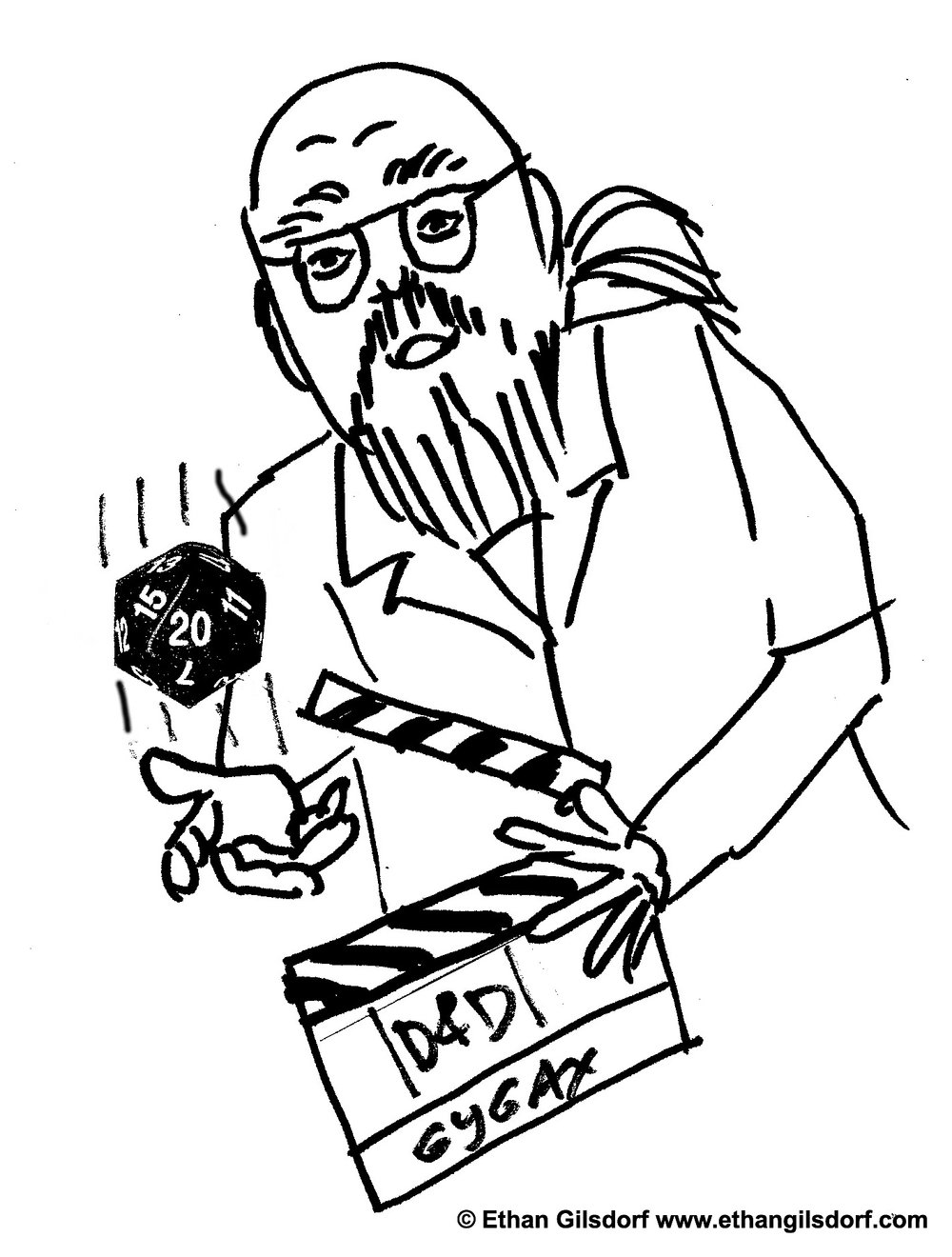 The Examiner.com has reported and confirmed a rumor that’s already been echoing through the dungeons of D&D talk: that a Gary Gygax biopic is in the works. Michael Tresca wrote:
The Examiner.com has reported and confirmed a rumor that’s already been echoing through the dungeons of D&D talk: that a Gary Gygax biopic is in the works. Michael Tresca wrote:
George Strayton confirmed he is … the scriptwriter for a $150 million movie based on Gary Gygax’s life. George describes the film as a ‘combination action movie and bio pic.’ The movie will tell the story of how Gary created Dungeons & Dragons, switching between his real life and the fantasy realm of Dungeons & Dragons.
Strayton is the CEO/Lead Designer of Secret Fire Games, as well as a writer for TV series Hercules: The Legendary Journeys andXena: Warrior Princess, and the animated feature Dragonlance: Dragons of Autumn Twilight.
Another morsel: Tresca said that “George let it slip that a ‘huge star is playing Gary.’”
I’m game.
That said, some skeptical voices have already begun to pepper the blogosphere. As James Maliszewski says over at Grognardia, “I’d frankly be amazed if any studio thought that the life of Gary Gygax had enough mass appeal to be made into a movie, let alone one with a big budget and a huge star.” It’s an excellent question.
This certainly raises the question if the non-nerd world is ready for a biopic on an essential, but for many, still unknown pop culture innovator who helped usher in a new gaming and leisure genre. The Whole Wide World, the 1996 film about Robert E. Howard, creator of Conan the Barbarian, and starring Vincent D’Onofrio and Renée Zellweger, proved that more obscure subjects for biopics can be made. But … while that film was largely well-received critically, it tanked at the box office.
The life of Gygax and genesis of D&D certainly sounds like a promising idea for a movie. Who among lovers of RPGs won’t want to see the reenactments of D&D’s early years? Those behind-the-scenes scenes of early play-testing? And to settle once and for all the junk food dilemma — did Gary prefer Doritos or Cheetos?
More updates on this as I hear more.
Two New Books Lavish in 80s Video Game Culture
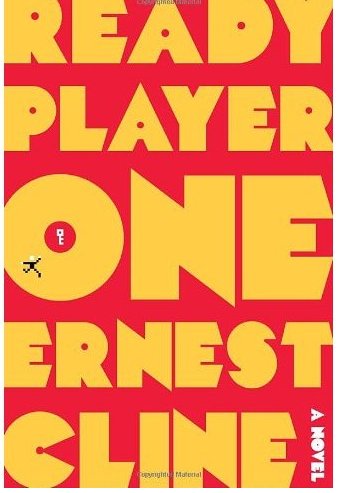 READY PLAYER ONE By Ernest Cline [Crown, 374 pp. $24.00]
READY PLAYER ONE By Ernest Cline [Crown, 374 pp. $24.00]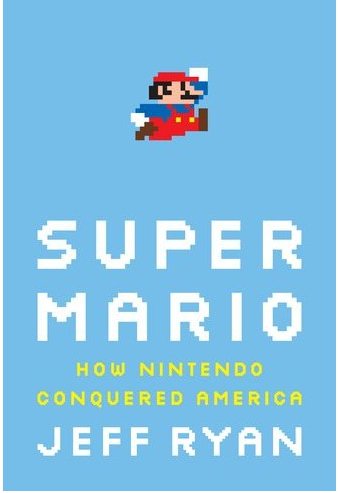 SUPER MARIO: How Nintendo Conquered America, By Jeff Ryan [Portfolio, 292 pp., $26.95]It’s easy to cast a long shadow of nostalgia across your geeky past, now that you are standing taller.
SUPER MARIO: How Nintendo Conquered America, By Jeff Ryan [Portfolio, 292 pp., $26.95]It’s easy to cast a long shadow of nostalgia across your geeky past, now that you are standing taller.
There’s no shame, no risk of ridicule or reprisal, now that nerds top the food chain. More confident, you might even find yourself admitting, “Sure, I used to play Dungeons & Dragons. Had an 18th-level paladin named Argathon. One righteous orc-slaying dude.’’
I do. I played more than my share of video and role-playing games during a less friendly era, the 1980s. Fantasy and science fiction had not come out of the closet. The financial success of genre franchises had not yet made geekery acceptable. Gaming culture was nonexistent.
A bonus of my then fringe game habit: It felt user-driven, indie, even subversive. When free time, not money, was my currency, gaming created a peculiar, and intimate, community. I inserted real quarters into singular machines shared with others. No Internet. No interruptions from texts. Total immersion in virtual worlds was possible even as, paradoxically, cutting-edge special effects were analog, not digital.
And a game of Donkey Kong, its chunky graphics about as sophisticated as the dungeons I sketched on graph paper, might last only a minute, while a game of D&D, limited to the primitive technology of dice, pencils, and brainwaves, would take months.
Differing both in approach and success level, two new books -- Ernest Cline’s dystopian sci-fi novel “Ready Player One’’ and Jeff Ryan’s historical reportage “Super Mario: How Nintendo Conquered America’’ -- plumb and pay tribute to the genesis of our gaming culture. To a time when to find out who was the best at Asteroids or Galaga, you hoofed it down to the mall to witness the heroism gracing the “high score’’ screen, where someone’s tag -- “ZAK’’ or “LED’’ -- was hallowed only in the halls of your local arcade.
 Ryan, a video game critic, painstakingly charts the Japanese company Nintendo’s startling success. When its 1980 Space Invaders rip-off Radar Scope failed, technicians retrofitted 2,000 of the machines with a new arcade game, designed by an underling named Shigeru Miyamoto. Donkey Kong was born, as was the character Mario, based on a real mustachioed landlord who once showed up at Nintendo’s US headquarters to collect the rent and “grew so incensed he almost jumped up and down.’’ The red overalls and hat came later.
Ryan, a video game critic, painstakingly charts the Japanese company Nintendo’s startling success. When its 1980 Space Invaders rip-off Radar Scope failed, technicians retrofitted 2,000 of the machines with a new arcade game, designed by an underling named Shigeru Miyamoto. Donkey Kong was born, as was the character Mario, based on a real mustachioed landlord who once showed up at Nintendo’s US headquarters to collect the rent and “grew so incensed he almost jumped up and down.’’ The red overalls and hat came later.
Ryan does a fine job describing Nintendo’s growing rivalry with Atari and Sega and subsequent shrewd moves, as arcades shuttered, to dominate the home console market. Super Mario Bros. became the “dense’’ game-changing killer app, Ryan writes, which “called for deep exploration instead of facile button mashing.’’ A new generation of gamers could explore endlessly, wandering tubes, hopping platforms, and collecting shells and coins. Nabbing the high score wasn’t the point. Mario helped kill quarter-based game culture.
Ryan can be insightful, and his prose colorful, but also distracting. Images and metaphors compete and clash - the Zucker Brothers follow Derrida, a music reference is slammed cheek-by-jowl with a baseball analogy. At times, the text seems translated from the Japanese. What is “a nebula’s improvement in graphics’’? A “veritable sleuth of unsold Teddy Ruxpins’’? It’s also difficult to picture the graphical evolution of Mario and his game world when the book has no illustrations.
Most frustratingly, we never hear directly from any Nintendo designers, not even Miyamoto or company head Hiroshi Yamauchi. Curiously little on-the-ground reporting of personal travails or internal corporate tensions. After the first 100 pages, the narrative devolves into a cheery laundry list of game releases. It’s as if Ryan reported the book from the distance of the Internet.
Still, “Super Mario’’ remains an important link to understanding how we got from Donkey Kong to Wii, and why the wee Jumpman still rules. “Mario is the id: working off of instinct, never having much of a plan, always able to leap into the middle of things. We all become younger as we play Mario, because when we’re Mario we simply play.’’
More so than Ryan, Cline banks on blatant nostalgia for our geeky pasts. The year is 2044 and the young protagonist of “Ready Player One,’’ 17-year-old orphan Wade Watts, narrates his own progress in an elaborate, online scavenger hunt. He lives as an economic refuge in a crime-ridden shanty town, “The Great Recession was now entering its third decade,’’ Watts says, and like many who have given up on the “real world,” he spends his waking hours as an avatar, named Parzival, in a massive, Matrix-like virtual space called OASIS.
Created by a reclusive, Reagan-era game designer, the game melds Tolkienesque riddles with ’80s pop arcana - from Matthew Broderick’s lines in “WarGames’’ to dungeons designed by D&D co-creator Gary Gygax. Solve the puzzles and you inherit the game designer’s vast fortune. An old-fashioned “high score’’ leader board pops up periodically in the narrative to remind us who’s winning.
Such is the post-apocalyptic, nerd-friendly premise of “Ready Player One.’’ Watts is one of thousands of other players known as “gunters,” or “egg hunters” because they are looking for Easter eggs, or clues, hidden in the thousands of designer virtual lands that populate the OASIS. Watts steeps himself in the period, eschewing the world of 2044 to effectively live and breathe the era’s most mundane factoids, memorizing characters from “The Breakfast Club,” plot points from “Star Wars,” tactics for an obscure arcade game like Joust. Clearly having fun with the reader, and himself, Cline stuffs his novel with a cornucopia of pop culture, as if to wink to the reader, “Remember the TRS-80? Wasn’t it cool?’’ The conceit is a smart one, and we happily root for Watts/Parzival and his gaming buddies on their quest for the big egg -- and hope they win before a villainous, corporate-run gaming guild declares “game over.’’
Not that the novel is without its problems. Cline, the screenwriter who gave us “Fanboys,’’ oddly chooses a first-person narrator. What is the occasion for a 17-year-old explaining the plot of “Blade Runner,’’ or that “ ‘2112,’ Rush’s classic sci-fi-themed concept album’’ hit record stores “in 1976, back when most music was sold on twelve-inch vinyl records’’? Long, awkward passages of exposition bog down the story, and conflict with Watts’s own distinctive narrative voice. A third-person, roving point of view would more logically allow for these passages of authorial intrusion. Also a bummer: Much of the action is virtual, statically describing Watts’s online moves: “I took a screenshot of this illustration and placed it in the corner of my display.’’
One can picture much of this working better on the big screen, where asides won’t be needed. We’ll hear “She Bop” on the soundtrack or see a character wearing a “Muppet Show” T shirt and get it. No surprise, Cline’s movie adaptation of Ready Player One has already been sold.
But ignore these narrative hiccups and “Ready Player One’’ provides a most excellent ride. Once the story is up and running, and the novel blasts to its world-ending climactic battle, I found the adventure story and its revenge of the dorks dream fully satisfying.
Both Cline and Ryan’s books lavish in the toys and pastimes of our youth. And also nostalgia, which may soft-focus the hard and real edges, and yet we're happy to lavish in it nonetheless. We aging humans traffic in it. Perhaps we must to make sense of our past lives.
Like the film “Super 8,’’ these two books play also into a final fantasy: that things were once simpler. Today, some attribute the violence in Norway, unfairly, to video games. Suddenly ’80s pop culture looks less troubled. But of course, the arcade and role-playing games of yore were controversial scourges bent on the destruction of youth. Remember?
Soylent Green, and Gaming, Is People: Final Thoughts From Gen Con
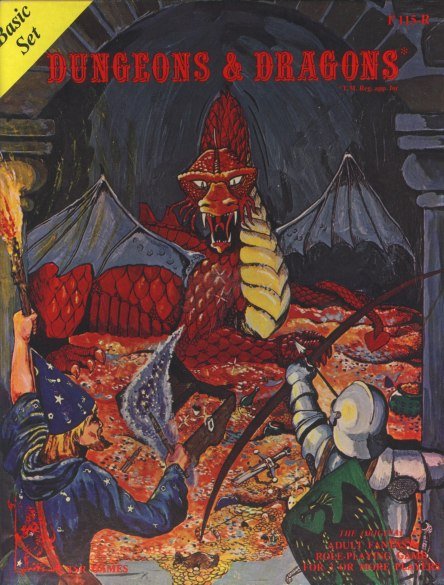 Is your Basic D&D set worth millions?The booths have been dismantled, the games put away, the green goblin face paint washed off, and the last of the trolls, pirates and grognards have been swept from the halls of the Indiana Convention Center.
Is your Basic D&D set worth millions?The booths have been dismantled, the games put away, the green goblin face paint washed off, and the last of the trolls, pirates and grognards have been swept from the halls of the Indiana Convention Center.
Gen Con may be over, but the ongoing campaign is not.
While of course the main reason gamers flock to Gen Con is to demo new product releases – and for sure, there were oodles of new merch on the convention floor, from Fantasy Flight Games’s Star Wars card miniature games to Wizards of the Coast D&D Neverwinter campaign setting – what I noticed, above all, was the spirit of gaming.
There's an ad in the Indianapolis Airpoirt about "gaming," but that ad means casino gambling: poker, blackjack, slots. What I mean, and what Gen Con ultimately aims to promote, is true gaming. Play that's not about beating the system or bilking other players of their riches, but sharing the experience of adventure and fun.
Gaming is people. (Soylent Green is also people, but that's another story.)
Reflecting back on my four days at Gen Con Indy, here are some final words about the power of table-top and role-playing games.

 All weekend long, I wandered the vendor floor, the hallways and game rooms, but I kept returning to the Gen Con auction. Here, folks unload old games of all types, from D&D products to an old copy of Tunnels and Trolls to a forgotten board game like Dark Tower or Pac-Man. On Friday night, the best of the best collector items were bid on and bought. I watched Kask and fellow TSR veteran game designer Frank Mentzer (founder of the Role-Playing Games Association), both serving as auctioneers, scrutinize an old D&D Basic set, trying to ascertain whether it was a first or third printing and whether the shrink wrap and Toys “R” Us sticker were authentic. I was fascinated by the love and passion these games attract, as well as the desire to get the details right. And the humor: After the winning bid on that Basic set, the auctioneers tore open the shrink wrap to see what was inside. (Sorry, winner, it was nothing special.) The desire to know the "guts" trumped any persnickety OCDism to keep the package intact for posterity's sake.
All weekend long, I wandered the vendor floor, the hallways and game rooms, but I kept returning to the Gen Con auction. Here, folks unload old games of all types, from D&D products to an old copy of Tunnels and Trolls to a forgotten board game like Dark Tower or Pac-Man. On Friday night, the best of the best collector items were bid on and bought. I watched Kask and fellow TSR veteran game designer Frank Mentzer (founder of the Role-Playing Games Association), both serving as auctioneers, scrutinize an old D&D Basic set, trying to ascertain whether it was a first or third printing and whether the shrink wrap and Toys “R” Us sticker were authentic. I was fascinated by the love and passion these games attract, as well as the desire to get the details right. And the humor: After the winning bid on that Basic set, the auctioneers tore open the shrink wrap to see what was inside. (Sorry, winner, it was nothing special.) The desire to know the "guts" trumped any persnickety OCDism to keep the package intact for posterity's sake.
Thankfully, more than just old timers are keeping the old RPGs alive. Publishing collectives like The Old School Renaissance Group and voices like the Blog of Holding are intent on honoring the groundbreaking heritage of D&D. A downloadable gaming product called Old School Hack is doing its best to introduce a streamlined, D&D-like RPG experience to a new generation of players. “A hack of a hack of the original Red Box version of a certain popular hack-and-slash fantasy game,” is what the folks say about their wee little product. Old School Hack also won the best free product “gold” award at Gen Con’s ENnies, the game industry’s version of the Oscars/Emmys. I applaud Kirin Robinson, the man behind OSH, who humbly notes, “I’m certainly not any sort of professional game designer, just another hobbyist looking to put together a fun game.” Here are all ENnie winners.
[Side note: In a funny, tongue-in-cheeky move, at the ENnie awards ceremony, every time Wizards of the Coast won a silver or gold, the “Imperial Death March” theme from the Empire Strikes Back would sound. Hanging out at their spectacular, ruined castle booth a lot this weekend, I know Wizards has a sense of humor.]
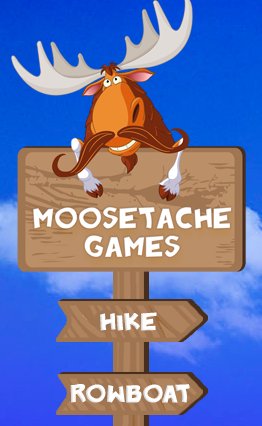 Moosetache Games: Teaching that not all kids games involve a video monitor and controllerSeriously, evil empire jokes and fancy booth bling aside, Gen Con also reminded me of about the enthusiasm of the hundreds of indie gamer designers who exhibit their dreams here. Their only hope? To get a few dozens players excited about their new adventure. Tiny companies, like Moosetache Games, who debuted their new card game Hike, a family card game that encourages cognitive learning and teaches children about nature, took the time to teach anyone who wanted to learn. After all, the best way to try a new game is to play it. And no better way than from the folks who make it.
Moosetache Games: Teaching that not all kids games involve a video monitor and controllerSeriously, evil empire jokes and fancy booth bling aside, Gen Con also reminded me of about the enthusiasm of the hundreds of indie gamer designers who exhibit their dreams here. Their only hope? To get a few dozens players excited about their new adventure. Tiny companies, like Moosetache Games, who debuted their new card game Hike, a family card game that encourages cognitive learning and teaches children about nature, took the time to teach anyone who wanted to learn. After all, the best way to try a new game is to play it. And no better way than from the folks who make it.
I also hung out with the folks behind an exciting new project, Dungeons & Dragons: A Documentary, who (like me) aim to tell the whole story of how a simple yet innovative, fantasy role-playing game changed the course of millions of lives, and the history of our culture. And how D&D is still inspiring people to be creative writers, thinkers, and problem-solvers .
And I spoke to Gail Gygax, wife of the late Gary Gygax, and their son Luke Gygax, who are intent on making sure that the legacy of Gary and his contributions to the game are remembered. They both gave a moving tribute to Gary at the ENnie awards. And their Gygax Memorial Fund is still soliciting donations. You can even record your own video testimonial for the website.
Which brings me back to my over-aching feeling upon departing Gen Con: that table-top, roleplaying gaming is really about people. Gaming brings folks together around a table to banter and bargain and be boisterous. To share a playful experience outside of work, responsibilities, outside of the boxes we have drawn around ourselves. Adults need as much free, unstructured down time as kids. Let’s not forget that. We need to goof off, too.
And as cool as richly-imagined digital worlds can be, in game playing, it's the quality and passion of the company around the living room table that count, not the impressive gadgets and graphics. This is a lesson we especially should teach kids, who need to understand that not all games need involve a video monitor and a digital graphics. The power of the raw imagination needs to be preserved.
Hope to see you at next year’s Gen Con (or any of the hundreds of smaller game cons that have sprung up, including Gary Con IV in March, 2012, where you can game with many gaming legends).
Now, go play a game. Have fun.
On His Birthday (Today), You Can Help the Memory of Gary Gygax Last Forever
[Originally appeared on wired.com's GeekDad]
 Logo for the Gygax Memorial Fund. Also the Gygax family heraldry, this shield was used by the knight on the cover of the AD&D DM's Guide and was the coat of arms of the city-state Fax in the campaign setting of Greyhawk.Today (July 27) is the birthday of Gary Gygax, who would have been 73 this year had he not passed from this earth in 2008 to dance forever on the astral plane, which (according to the DM’s Guide) is a realm of thought and memory, and also the place the gods go when they die or have been forgotten.
Logo for the Gygax Memorial Fund. Also the Gygax family heraldry, this shield was used by the knight on the cover of the AD&D DM's Guide and was the coat of arms of the city-state Fax in the campaign setting of Greyhawk.Today (July 27) is the birthday of Gary Gygax, who would have been 73 this year had he not passed from this earth in 2008 to dance forever on the astral plane, which (according to the DM’s Guide) is a realm of thought and memory, and also the place the gods go when they die or have been forgotten.
Gygax, D&D’s co-founder, is gone, but certainly not forgotten. One way he’s being immortalized is in bronze and stone. Previously I wrote for GeekDad about the Gygax Memorial Fund and the increasing likelihood that a monument in his honor will be built in Gary’s hometown of Lake Geneva, WI. The city has granted parkland for the memorial, and the fund has incorporated as a 501(c)3 nonprofit.
Now the next step is to raise money, and the hope is for much of the dough to be croudfunded, with this year’s Gen Con and Gary’s birthday as the impetus.
D&D die-hard and occasional Geek Dad contributor Tavis Allisontells me that at this year’s Gen Con (Aug. 4-7), the fundraising for the monument begins in earnest. Gen Con, you see, was Gary’s baby.
Over at the booth for ye Old School Renaissance Group (booth #1541), a collective of publishers and fans working to carry the torch of Dungeons & Dragons the way Gygax and co-creator Dave Arneson imagined it, Mr. Allison says Gary’s widow, Gail Gygax, will be “talking about conversations she had with her husband before his death about how he wanted to be remembered, the resulting vision for the statue, and the goals of the Memorial Fund.”
And I can’t imagine anyone who stops by to drop some spare change in the bucket will be refused.
 This illustration by Erol Otus is the cover of a new book Cheers, Gary a collection of Gary's correspondence with his fans. The image is Gary, as the wizard seen on the front of the original D&D box set.To encourage you to give, Tavis says that cool donor rewards include T-shirts with the Gygax Memorial logo, and a book calledCheers, Gary “which selects the best of his correspondence with fans at the EN World Q&A threads.” Editor Paul Hughes will be signing books, which have an Erol Otus illustration on the front cover depicting Gary as the wizard seen on the front of the original D&D box set.
This illustration by Erol Otus is the cover of a new book Cheers, Gary a collection of Gary's correspondence with his fans. The image is Gary, as the wizard seen on the front of the original D&D box set.To encourage you to give, Tavis says that cool donor rewards include T-shirts with the Gygax Memorial logo, and a book calledCheers, Gary “which selects the best of his correspondence with fans at the EN World Q&A threads.” Editor Paul Hughes will be signing books, which have an Erol Otus illustration on the front cover depicting Gary as the wizard seen on the front of the original D&D box set.
The big goal? Raise $500,000 via Kickstarter. Allison thinks it’s doable, with your help, of course.
“I think there is real potential for the Fund to achieve the $500K goal for this campaign through crowdfunding alone. This would be the most ambitious Kickstarter goal in history, but it’s not unprecedented and if Gary doesn’t have ten times the dedication than Robocop does I’ll eat my dice bag,” Tavis says.
To help continue the Fund’s momentum, and in recognition of everything Gary meant to gamers everywhere, Allison asks for your assistance in getting the word out about these efforts. Even if you can’t make it to Gen Con, please pay tribute to Gary’s birthday and the role D&D played in your life by posting news to your blogs, social networks, and communities that the Gygax Memorial Fund will be at Gen Con booth number #1541, and that folks can donate in memory of Gary at Gen Con, or directly on the website,http://www.gygaxmemorialfund.com/.
See you in the dungeon.
Gygax memorial makes progress
 Gary Gygax the way the folks at "Futurama" drew his cartoon versionLake Geneva, Wisconsin, was always a mythical land of enchantment to me, a kid raised far away on the east coast who spent much — OK, way too much — of his allowance on Dungeons & Dragons gear.
Gary Gygax the way the folks at "Futurama" drew his cartoon versionLake Geneva, Wisconsin, was always a mythical land of enchantment to me, a kid raised far away on the east coast who spent much — OK, way too much — of his allowance on Dungeons & Dragons gear.
While the mailing address — TSR Hobbies, Inc., POB 756, Lake Geneva WI 53147, U.S.A. — felt like an imaginary realm, I knew it was also a real land where that mysterious co-creator and co-godfather of D&D lived and worked: Gary Gygax.
When my local hobby shop didn’t have a module or rule book on their shelves, I’d mail in my order form directly to the source in Lake Geneva (with my check, of course, that covered the price plus “shipping and handling”). The elves and orcs who toiled there would fill my order, and in a few weeks I’d get a package in my mailbox. And the next crucial adventure could continue.
Ever since Gygax passed away in 2008, his widow Gail Gygax and others have spearheaded an effort to honor him and his contribution to gaming lore with a public monument in Lake Geneva. The Gygax Memorial Fund website just announced that goal is one step closer:
The Gygax Memorial Fund has reached a huge milestone. We have been granted land for the memorial site at Donian Park. Donian Park is a four acre open space site which encompasses a wetland and the 100 year recurrence interval floodplain along the White River in downtown Lake Geneva.
On the website for the Gygax Memorial Fund, there’s a link to donate, if you are so inclined. There’s also a forum to share your testimonials of how Gary and D&D changed your life for the better.
Long live Gary!
We all role-play now
[Note: Ethan Gilsdorf speaks at the Boston Public Library Wed, Oct 20. Other upcoming speaking engagements: Attleboro, MA: Oct. 29th (part of a Creature Double Feature tribute!); Brattleboro, VT: Nov 11th; Somerville, MA: Nov 13th; Cambridge, MA: Nov 15th; Providence, RI: Nov 18th; Burlington, MA: Nov 20th; Brooklyn, NY: Nov 22nd. More book tour info here]
We all role-play now
Those Dungeons & Dragons skills can come in handy in the world of Facebook
"The Social Network,'' Hollywood's latest box office king, charts Facebook's meteoric rise to near ubiquity. Few have not heard of the world-girdling website or been ensnared by its tendrils. In six years, Facebook has woven its way into the daily lives of some 500 million users.
Whether to check up on friends' exploits or play games like "Mafia Wars,'' we've grown accustomed to its promise of instant intimacy and, some might argue, its voyeuristic pleasures. Many cheer the way Facebook has democratized the flow of information; no longer top-down, news is now horizontally and virally dispersed. Others gripe that it's warped our idea of significance, making what I had for breakfast as important as the latest developments in the Mideast peace process. Facebook's vast and sticky web of connection has caused us all to re-evaluate what we mean by "friend.'' And, I suppose, "enemy'' as well.
Unforeseen social aftershocks such as these have rippled in Facebook's wake. Others have yet to be detected. But there's something else at work with Facebook. It's actually making role-players of us all.
 Role-playing? Like that conflict-resolution exercise your sales team endured last year? Or role-playing, as in Dungeons & Dragons - that strange and wondrous game I (and perhaps you) played back in the Reagan administration, rolling dice in a basement and slaying goblins and dragons and snarfing bowls of Doritos?
Role-playing? Like that conflict-resolution exercise your sales team endured last year? Or role-playing, as in Dungeons & Dragons - that strange and wondrous game I (and perhaps you) played back in the Reagan administration, rolling dice in a basement and slaying goblins and dragons and snarfing bowls of Doritos?
I'd argue all these experiences - including posting a witty Facebook update - are cut from the same role-playing cloth. We all share that desire to be someone else. To be better, stronger, faster; to appear more handsome, more clever, more attractive than our fleshy selves might ever be. "My, aren't we having fun?'' say our photos, snapped while we're half drunk and posted in a day-after haze. On my Match.com profile, I offer clues that might seduce. I suggest, in a whisper of pixels, "I am your ideal man.''
Not that role-playing is devious. It's a necessary counter to the way we've been civilized. While hidden behind the screen, we give ourselves permission to behave more dauntless or brazen than we'd allow in real life. We get to practice being the best version of the person we can be, or want to be.
That said, some role-playing experiences, especially offline ones, are deemed more acceptable than others. Dressing up as Tom Brady and painting your body blue and red for the big game? That's OK. Dressing as Gandalf and wearing a purple wizard hat for the big game? Not so much. Even as World of Warcraft and D&D and Harry Potter fandom have become passable in many circles, adults raiding Mom's closet for goofy clothes for "make-believe'' still remains verboten.
Except, of course, at Halloween. This odd holdover from pagan times is a socially acceptable way to bust loose. Here, costumes are fine. And playing "bad'' is encouraged. Being Dracula or Nurse Hottie for an evening can be instructive, even liberating.
The irony here is that even in our pre-Facebook existences, we've always engaged in day-to-day role-playing. At a wedding or cocktail party, on a first date or during a job interview, or when home for the holidays, we all dress the part and adopt another character: Brilliant or Well Adjusted, Stockbroker or Salesman, Happy Son or Perfect Mom. If you're not willing to play along and put on a mask, friends (and potential employers) will think, "What's wrong? Come on, get into character.'' Life is a dungeon crawl, full of monsters and opportunities to be on your mettle. Be prepared. Chin up.
So here's the rub. Eventually, we have to live up to these personas we've created. Many a first date has witnessed the crumbling of expectation's towers and spires. And despite my hundreds of Facebook friends, I wonder who I can really count on in times of trouble. When I really do need to be brave and slay that dragon.
Ethan Gilsdorf is author of Fantasy Freaks and Gaming Geeks: An Epic Quest for Reality Among Role Players, Online Gamers, and Other Dwellers of Imaginary Realms, now in paperback. More info on Gilsdorf and the book here.
Dungeons & Dragons Saved My Life
 The author, circa 1982
The author, circa 1982
The summer before my eighth-grade year, when I was 12, I learned to escape.
This was 1979. My mother had been home from the hospital for a few months, and my sister, brother and I were still coming to understand the “new Mom.”
This new mother had survived a brain aneurysm. Her left side was mostly paralyzed, and she behaved strangely. Sometimes she scared me. We called her the Momster.
I couldn’t tame her, not this beast, and I knew I couldn’t save her, either. I was stuck with a mother I didn’t know how to love
But later that summer, something wondrous happened—I learned how to face my demons in another way. I learned that sometimes, checking out from reality was not just a fun diversion, but necessary for survival.
 An article about that mysterious, possibly dangerous, new game fad D&D
An article about that mysterious, possibly dangerous, new game fad D&D
A new kid named JP had moved across the street from me. One hot August day, JP showed me a clever trick—how to step away from my own body and mind, my family, and travel to places I’d never even seen. A way out.
“Ever play D&D?” JP asked, standing in my kitchen, eyes bright and magnified behind his extra-thick glasses. He was quite short, frail-looking, but feisty and fast-talking.
“D&D?” I said. “What’s that—a board game?”
“Dungeons & Dragons? It’s not a normal board game. . . . See, you play a character. . . . There’s all these rules.” He rummaged through his backpack and pulled out a pile of books, then poured a sack of colorful objects onto the table. They looked like gemstones. “Check out these cool dice! See, I’m the Dungeon Master. I create a scenario, man adventure, a world. You tell me what your character wants to do.”
“Character? What do you mean?” I asked. This kid was weird.
Invented by two geeks in the Midwest, Gary Gygax and Dave Arneson, the was only five years old back in 1979. Few had ever played anything like this before. Born of a similar swords-and-scorcery, myth-laden backdrop as J.R.R. Tolkien's world of Middle-earth, D&D was a game where you got to take action, be the hero, go on a quest. The game taught social skills, leadership, and strategy; it inspired creativity and storytelling, and provided rites of passage, accomplishment and belonging, even belief systems. I didn't get it at the time, but D&D and its ilk let people safely try out aspects of their personalities --- often dark, evil sides, or extroverted or flirtatious --- they could not or would not flex in "real life." The games connected folks tomagical thinking, to nature, to a primal, pick-up-your-battle-ax and kill mentalities long suppressed by so-called society. All of which would later serve me well in life.
D&D would open up a universe of creative expression to shy, introverted, non-athletic kids like me who felt about as powerful as a three-foot hobbit on the basketball team.
But at the moment, I was confused. I had no idea how play.
JP sighed. “OK, it goes like this. Pretend you’re in a dark woods. Up ahead on the path, you see a nasty-looking creature: seven feet tall, pointy ears, mouth full of black rotten teeth. ‘Friend or foe?’ it grumbles. Its fist tightens on the morning star in his hand, and it begins to heft it. Like this.” JP grabbed a frying pan off the stove. He swung it in the air. “What do you do?”
“What do I do?”
“It’s an orc. What do you want to do?”
“Uh . . . ” I stalled. What is going on? I thought. I didn’t even know what a morning star was. Or an orc.
"What are you going to do?" JP asked again, a little more impatiently.
“Uh, I’ll attack? With my sword. Do I have a sword?”
JP rolled the dice and squinted at a rulebook. “OK, your short sword strikes its shoulder. Black blood spurts out. It screams, ‘Arrghhh!’ You whack it for four hit points.”
“Cool.” I wanted to ask what a “hit point” was, but it didn’t matter. My anxiety, my weird home life, my mother’s limp, all of it began to fade. I was hooked. I didn’t know it at the time, but Dungeons & Dragons was about to save my life.
“Now the orc comes charging at you. He’s really mad.” JP bared his teeth for effect. “Now what do you do?” he asked, a big grin spreading across his face.
What do I do? I was 12. It was 1979. I had just discovered the power of escape, and vicarious derring-do. Later, I would learn much more about orcs and morning stars and a universe of wondrous things. There was so much I wanted to do.
Who needs varsity sports when you can be a wizard and shoot fireballs from your fingertips?
 Adapted from the Prologue to Ethan Gilsdorf's travel memoir and pop culture investigation Fantasy Freaks and Gaming Geeks: An Epic Quest for Reality Among Role Players, Online Gamers, and Other Dwellers of Imaginary Realms, now in paperback. More info:http://www.ethangilsdorf.com
Adapted from the Prologue to Ethan Gilsdorf's travel memoir and pop culture investigation Fantasy Freaks and Gaming Geeks: An Epic Quest for Reality Among Role Players, Online Gamers, and Other Dwellers of Imaginary Realms, now in paperback. More info:http://www.ethangilsdorf.com
Real-Life Role-Playing
Real-Life Role-Playing
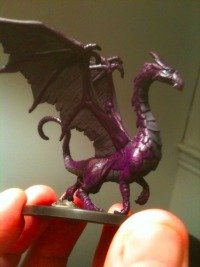 When Max Delaney came to rural Maine 13 years ago, his itinerant family moved from town to town, school to school. With few social connections, he felt isolated. Like an outsider.
When Max Delaney came to rural Maine 13 years ago, his itinerant family moved from town to town, school to school. With few social connections, he felt isolated. Like an outsider.
"It was hard for me to find people," says Mr. Delaney, now 21. "I was searching for a community." His academic performance suffered, and he didn't get along with his teachers. "I did not do well with authority in school."
Then, the year his family arrived in Belfast, a coastal town of some 6,300 on Penobscot Bay, he discovered The Game Loft and finally found his tribe.
Similar to other youth-development organizations such as Outward Bound or Scouting, The Game Loft also fosters risk-taking, leadership, and camarad erie. But for kids who find the football gridiron to be a foreign world, The Game Loft immerses them in a different sort of team sport.
Via table-top role-playing games like Dungeons & Dragons (D&D), Game Loft members play characters armed not with football padding and hockey sticks but chain mail, broadswords, light sabers, and magic spells. Working together, they charge onto battlefields and explore underground dungeons, seeking valor in these imaginary realms.
"I took to [role-playing] immediately," Delaney says. He joined as a member of The Game Loft, then started volunteering as a staff member, and finally became an employee. Along the way, the games he played built up his character in the real world.
"Killing dragons is a challenge," says Ray Esta brook, The Game Loft's codirector and cofounder. His center connects dragon-slaying to the challenges life throws at you. Via gaming, kids test out "roles," but in a safe, nonschool environment, in order to become functioning adults in society – connected, compassionate, and caring. "Good things happen to kids who game," he says.
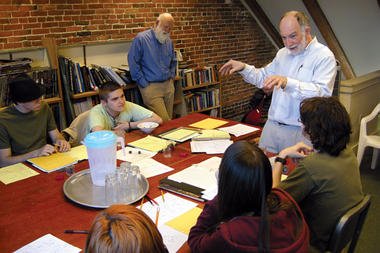 Cofounder Ray Estabrook (standing) leads gamers in playing '1968: Gone but Not Forgotten,' a game he and his wife and co-founder Patricia created.
Cofounder Ray Estabrook (standing) leads gamers in playing '1968: Gone but Not Forgotten,' a game he and his wife and co-founder Patricia created.
"I was [at The Game Loft] to socialize with kids who had mutual interest not only in games but conversation," Delaney says. "It was a place to channel a lot of curiosity." Moreover, he was able to interact with kids of all ages, as well as adults, who treated him as an equal. "The level of respect we got at The Game Loft was different than [at] school."
The Game Loft addresses another concern: the proliferation of video games. In an age when parents worry about the potentially isolating and addictive effects of computer and console-based games such as World of Warcraft and Halo, The Game Loft offers an antidote. No electronic games are allowed within its doors. Rather, kids play games
like D&D and Star Wars Miniatures face to face, with pencils and paper and plastic figurines, not with pixels and high-bandwidth Internet connections. A role-playing game is participatory, not passive. The kids don't absorb prefab plots from movies, books, or video games, but tell their own stories of their characters' exploits. Players around a
gaming table interact, completing quests and, yes, killing monsters who stand between them and their booty. In their imaginations, they are linked to humankind's narrativemaking past of heroic ballads and campfire tales of derring-do.
Each weekday at about 2 p.m., between 15 and 35 kids ages 6 to 18 (about one-quarter of them girls) break down the front door, pour up the stairs, and burst into The Game Loft's "Great Hall." The adjacent kitchen serves up hot food, sometimes the only nutritionally sound meal kids might get all day. They grab a brownie or bowl of chicken soup, separate into small groups (usually fewer than eight players) and head to the various rooms that host the game sessions. Once settled and fed, the kids quickly get down to the business of role-playing as elves and wizards, or plotting strategy as Jedi knights and military commanders.
But an unsupervised, free-for-all role-playing game can be just as cruel as a playground game of dodgeball. That's why game moderators like Tom Foster structure "intentional games" with outcomes that reinforce the center's principles such as fair play and cooperation.
In one room, called "The Savage Room" and decorated with maps and a suit of armor, Mr. Foster, who has been playing D&D since the 1970s, ran a multiweek, modified D&D game. He schooled his 12-to-15-year-old protégés in surviving the elaborate dungeon he'd designed and stocked with traps and monsters.
But when the adventuring party – "a group of misfits," as Foster affectionately called them – stepped on a tripwire, a cage opened that unleashed a bloodthirsty rhino.
Hands shot up, offering solutions. "I'm going to hide!" one girl shouted. "I've got an epic plan!" blurted another. "I want to jump on its back!" said another, whose character, inexplicably, took his clothes off and, via magic, turned invisible.
"Hold it, everyone! Focus," Foster said. "You've got a very large animal with three horns after you and you're arguing among yourselves." Eventually, they tricked the rhino into running into a vault and slammed the door. Success.
"Here, the idea is to get them from playing a game to solving problems," Foster later says. "To integrate."
Still, parents can be skeptical of the pedagogical goals. Some think their kids are just goofing off, says Kali Rocheleau, director of volunteers and membership. "But once we get them in the door, they have that 'aha' moment."
Sian Evans, whose two sons are Game Loft regulars, was one of those leery parents. She was no fan of video games, either, and wondered if fantasy games were too violent. But once she observed her sons in action, she noticed them begin to pass not only Pokémon cards back and forth across the gaming table, but also concepts.
"When you're playing D&D, you're talking about ideas," Ms. Evans says. "It's not games, it's life skills." She recalls a time that Taran, her 11-year-old, came home bubbling with enthusiasm about what had happened that day in the game: "Oh Mom, I got turned into a dwarf!"
"This is so special to him because he's active, he's part of the story," Evans says. "[Taran] would like to put a bunk bed in and live [at the Loft]."
The Game Loft's tools and settings aren't all fantasy. One custom-made game, 1968: Gone but Not Forgotten, re-creates life in a galaxy not so far, far away: Maine. "It's role-playing in an imaginary county, but touching on real history," says Patricia Estabrook.
"Our Maine history game is Dungeons & Dragons without the dungeons or the dragons," Ray Estabrook adds.
Games that let kids inhabit other selves from local history give them a stake in their own community. So do service projects that ask teens to take a break from battling orcs to give back. Townspeople see teens engaged in work like shoveling sidewalks for the elderly, not loitering downtown.
"It's important for youth to be involved in the community, not stuck behind some walled high school perimeter," Ray says.
For those at risk of dropping out of high school, The Game Loft can provide empowerment, accountability, and a way back in. Take Damion Saucier, 17, who felt oppressed by his school's educational system. "Me and school never clicked," Damion says. But at The Game Loft, he found "a big family," learned how to work with others, and also learned the necessity of obeying authority – sometimes. Now he's recommitted to school and volunteering as a game-session leader, teaching next-generation geeks. They look up to him. "You are like a god to them," he says. "It gives you a sense of helping these kids be social, and they're having fun."
The Game Loft has managed to turn the lingering "gaming is antisocial" stereotype on its head.
As for Max Delaney, just this March, after 11 years, he left his job at The Game Loft. The small-town kid moved to the faraway realm of Portland, Maine. He felt a little nervous, but also confident. After all, he knew how to role-play.
"We role-play in all situations in our life. It's unconscious," Delaney says. A job interview is really just role-playing, he notes, and games are a gateway to interaction. "We want to try to be someone else for just a little while, to experiment with it, to see who we can
be and what others are."
Like a character in a D&D game, who outfits himself before an adventure, then gains experience and grows in mastery, Delaney is well prepared for his next adventure – be it a job in social services, teaching, or wherever his quest may take him.
Ethan Gilsdorf is the author of Fantasy Freaks and Gaming Geeks: An
Epic Quest for Reality Among Role Players, Online Gamers, and Other
Dwellers of Imaginary Realms, which comes out in paperback in
September. Contact him through his website, www.ethangilsdorf.com
10 Business Lessons I Learned from Playing Dungeons & Dragons
10 Business Lessons I Learned from Playing Dungeons & Dragons
Some good advice here, especially this one:
The best quests require a mixture of skills in the party. Find new friends and cultivate ancillary skills. That pesky little hobbit thief may eat you out of house and home, yet sometimes he comes in pretty handy. This is the point of all those tedious "diversity training" exercises from your HR department; perhaps the message would get across better if they talked about the apparently-weak wizard and the bard with those amazing negotiation skills.
--- Ethan Gilsdorf, author of Fantasy Freaks and Gaming Geeks
